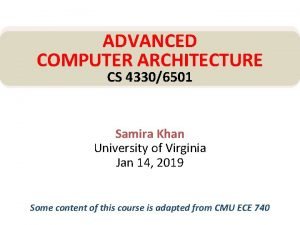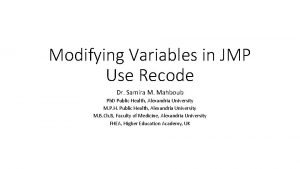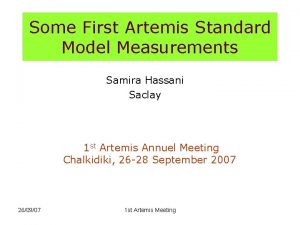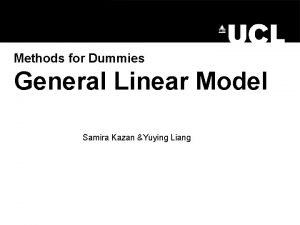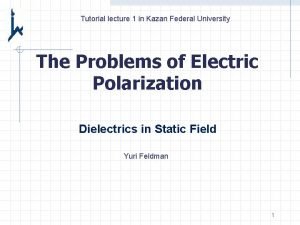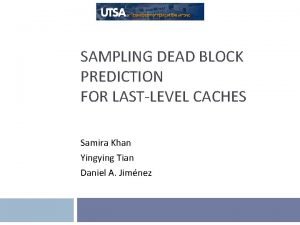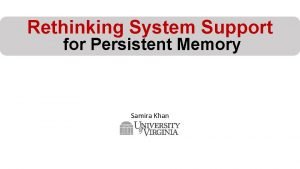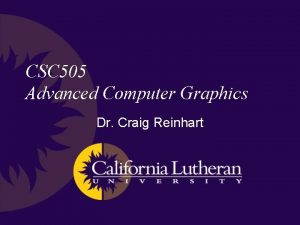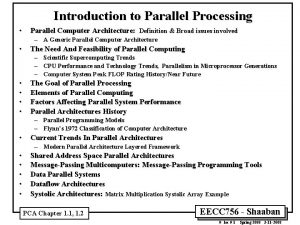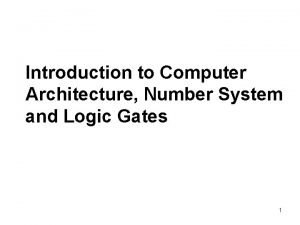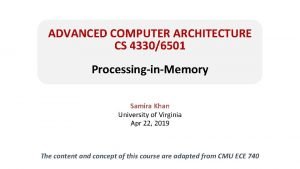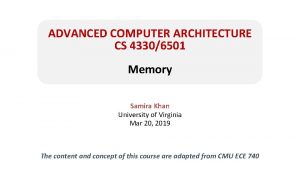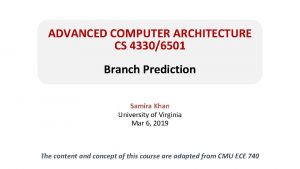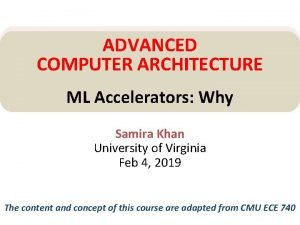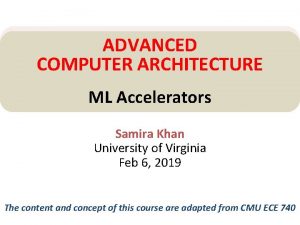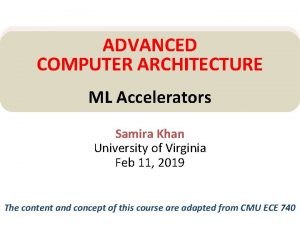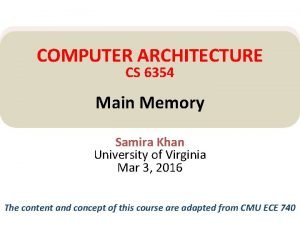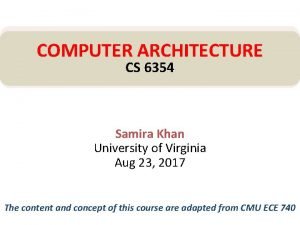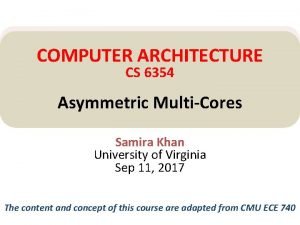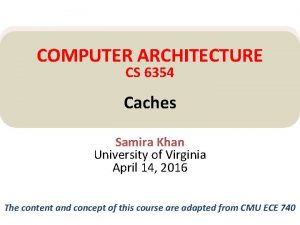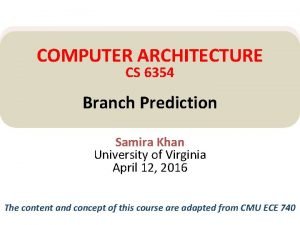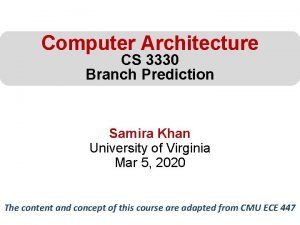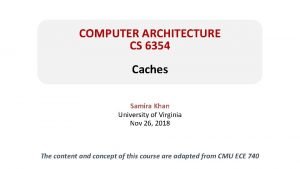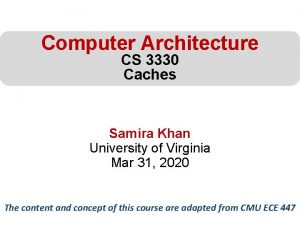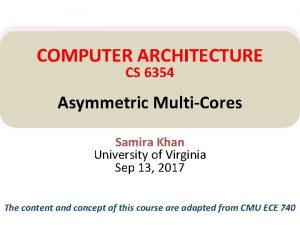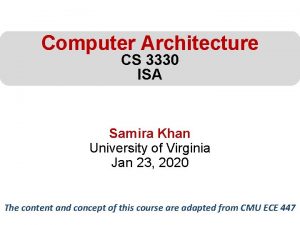ADVANCED COMPUTER ARCHITECTURE CS 43306501 ProcessinginMemory Samira Khan











































- Slides: 43

ADVANCED COMPUTER ARCHITECTURE CS 4330/6501 Processing-in-Memory Samira Khan University of Virginia Apr 3, 2019 The content and concept of this course are adapted from CMU ECE 740

LOGISTICS • Apr 8: Student Presentation 4 Scaling Distributed Machine Learning with the Parameter Server, OSDI 2014 ISAAC: A Convolutional Neural Network Accelerator with In-Situ Analog Arithmetic in Crossbars, ISCA 2016 • Apr 17: Take home exam • Apr 10: review and discussion class • Exam will focus on basic design fundamentals

Maslow’s (Human) Hierarchy of Needs Maslow, “A Theory of Human Motivation, ” Psychological Review, 1943. Maslow, “Motivation and Personality, ” Book, 1954 -1970. Everlasting energy Source: https: //www. simplypsychology. org/maslow. html 3

Do We Want This? Source: V. Milutinovic 4

Or This? Source: V. Milutinovic 5

Sub-Agenda: In-Memory Computation • Major Trends Affecting Main Memory • The Need for Intelligent Memory Controllers • Bottom Up: Push from Circuits and Devices • Top Down: Pull from Systems and Applications • Processing in Memory: Two Directions • Minimally Changing Memory Chips • Exploiting 3 D-Stacked Memory • How to Enable Adoption of Processing in Memory • Conclusion 6

Observation and Opportunity • High latency and high energy caused by data movement • Long, energy-hungry interconnects • Energy-hungry electrical interfaces • Movement of large amounts of data • Opportunity: Minimize data movement by performing computation directly where the data resides • • Processing in memory (PIM) In-memory computation/processing Near-data processing (NDP) General concept applicable to any data storage & movement unit (caches, SSDs, main memory, network, controllers) 7

Three Key Systems Trends 1. Data access is a major bottleneck • Applications are increasingly data hungry 2. Energy consumption is a key limiter 3. Data movement energy dominates compute • Especially true for off-chip to on-chip movement 8

The Need for More Memory Performance In-memory Databases Graph/Tree Processing [Mao+, Euro. Sys’ 12; Clapp+ (Intel), IISWC’ 15] [Xu+, IISWC’ 12; Umuroglu+, FPL’ 15] In-Memory Data Analytics Datacenter Workloads [Clapp+ (Intel), IISWC’ 15; Awan+, BDCloud’ 15] [Kanev+ (Google), ISCA’ 15]

Challenge and Opportunity for Future High Performance, Energy Efficient, Sustainable 10

The Problem Data access is the major performance and energy bottleneck Our current design principles cause great energy waste (and great performance loss) 11

The Problem Processing of data is performed far away from the data 12

A Computing System • Three key components • Computation • Communication • Storage/memory Burks, Goldstein, von Neumann, “Preliminary discussion of the logical design of an electronic computing instrument, ” 1946. 13 Image source: https: //lbsitbytes 2010. wordpress. com/2013/03/29/john-von-neumann-roll-no-15/

A Computing System • Three key components • Computation • Communication • Storage/memory Burks, Goldstein, von Neumann, “Preliminary discussion of the logical design of an electronic computing instrument, ” 1946. 14 Image source: https: //lbsitbytes 2010. wordpress. com/2013/03/29/john-von-neumann-roll-no-15/

Today’s Computing Systems • Are overwhelmingly processor centric • All data processed in the processor at great system cost • Processor is heavily optimized and is considered the master • Data storage units are dumb and are largely unoptimized (except for some that are on the processor die) 15

Yet … • “It’s the Memory, Stupid!” (Richard Sites, MPR, 1996) Mutlu+, “Runahead Execution: An Alternative to Very Large Instruction Windows for Out-of-Order Processors , ” HPCA 2003.

The Performance Perspective (Today) • All of Google’s Data Center Workloads (2015): 17 Kanev+, “Profiling a Warehouse-Scale Computer, ” ISCA 2015.

The Performance Perspective (Today) • All of Google’s Data Center Workloads (2015): 18 Kanev+, “Profiling a Warehouse-Scale Computer, ” ISCA 2015.

Perils of Processor-Centric Design • Grossly-imbalanced systems • Processing done only in one place • Everything else just stores and moves data: data moves a lot Energy inefficient Low performance Complex • Overly complex and bloated processor (and accelerators) • To tolerate data access from memory • Complex hierarchies and mechanisms Energy inefficient Low performance Complex 19

Perils of Processor-Centric Design Most of the system is dedicated to storing and moving data 20

The Energy Perspective Dally, Hi. PEAC 2015 21

Data Movement vs. Computation Energy Dally, Hi. PEAC 2015 A memory access consumes ~1000 X the energy of a complex addition 22

Data Movement vs. Computation Energy • Data movement is a major system energy bottleneck • Comprises 41% of mobile system energy during web browsing [2] • Costs ~115 times as much energy as an ADD operation [1, 2] [1]: Reducing data Movement Energy via Online Data Clustering and Encoding (MICRO’ 16) [2]: Quantifying the energy cost of data movement for emerging smart phone workloads on mobile platforms (IISWC’ 14) 23

We Need A Paradigm Shift To … • Enable computation with minimal data movement • Compute where it makes sense (where data resides) • Make computing architectures more data-centric 24

Goal: Processing Inside Memory Processor Core Database Graphs Cache Media Query Interconnect Results Problem Algorithm • Many questions … How do we design the: • compute-capable memory & controllers? • processor chip and in-memory units? • software and hardware interfaces? • system software and languages? • algorithms? Program/Language System Software SW/HW Interface Micro-architecture Logic Devices Electrons

Why In-Memory Computation Today? Dally, Hi. PEAC 2015 • Push from Technology • DRAM Scaling at jeopardy Controllers close to DRAM Industry open to new memory architectures • Pull from Systems and Applications • Data access is a major system and application bottleneck • Systems are energy limited • Data movement much more energy-hungry than computation 26

Agenda • Major Trends Affecting Main Memory • The Need for Intelligent Memory Controllers • Bottom Up: Push from Circuits and Devices • Top Down: Pull from Systems and Applications • Processing in Memory: Two Directions • Minimally Changing Memory Chips • Exploiting 3 D-Stacked Memory • How to Enable Adoption of Processing in Memory • Conclusion 27

Processing in Memory: Two Approaches 1. Minimally changing memory chips 2. Exploiting 3 D-stacked memory 28

Approach 1: Minimally Changing DRAM • DRAM has great capability to perform bulk data movement and computation internally with small changes • Can exploit internal connectivity to move data • Can exploit analog computation capability • … • Examples: Row. Clone, In-DRAM AND/OR, Gather/Scatter DRAM • Row. Clone: Fast and Efficient In-DRAM Copy and Initialization of Bulk Data (Seshadri et al. , MICRO 2013) • Fast Bulk Bitwise AND and OR in DRAM (Seshadri et al. , IEEE CAL 2015) • Gather-Scatter DRAM: In-DRAM Address Translation to Improve the Spatial Locality of Non-unit Strided Accesses (Seshadri et al. , MICRO 2015) • "Ambit: In-Memory Accelerator for Bulk Bitwise Operations Using Commodity DRAM Technology” (Seshadri et al. , MICRO 2017) 29

Starting Simple: Data Copy and Initialization Bulk Data Copy src dst Bulk Data Initialization val dst

Bulk Data Copy and Initialization Bulk Data Copy src dst Bulk Data Initialization val dst

Starting Simple: Data Copy and Initialization memmove & memcpy: 5% cycles in Google’s datacenter [Kanev+ ISCA’ 15] 00000 Forking Zero initialization (e. g. , security) Checkpointing Many more VM Cloning Deduplication Page Migration 32

Today’s Systems: Bulk Data Copy 1) High latency 3) Cache pollution CPU L 1 Memory L 2 L 3 MC 2) High bandwidth utilization 4) Unwanted data movement 1046 ns, 3. 6 u. J (for 4 KB page copy via DMA) 33

Future Systems: In-Memory Copy 3) No cache pollution 1) Low latency Memory CPU L 1 L 2 L 3 MC 2) Low bandwidth utilization 4) No unwanted data movement 1046 ns, 3. 6 u. J 90 ns, 0. 04 u. J 34

Row. Clone: In-DRAM Row Copy 4 Kbytes Idea: Two consecutive ACTivates Negligible HW cost Step 1: Activate row A Step 2: Activate row B DRAM subarray Transfer row Row Buffer (4 Kbytes) 8 bits Data Bus

Row. Clone: Intra-Subarray VDD/2 V +DD δ src 0 dst 0 V VDD DD/2 + δ Amplify the difference Data gets copied Sense Amplifier (Row Buffer) VDD/2 0

Row. Clone: Fast Row Initialization 0 0 0 Fix a row at Zero (0. 5% loss in capacity) 37

Row. Clone: Bulk Initialization • Initialization with arbitrary data • Initialize one row • Copy the data to other rows • Zero initialization (most common) • • Reserve a row in each subarray (always zero) Copy data from reserved row (FPM mode) 6. 0 X lower latency, 41. 5 X lower DRAM energy 0. 2% loss in capacity 38

Row. Clone: Advantages & Disadvantages • Advantages + Simple + Minimal change to DRAM • Disadvantages - Data needs to map to subarrays - Slow if data maps to different regions in memory - Need to expose the interface to the system - What is updated data was in cache? 39

Agenda • Major Trends Affecting Main Memory • The Need for Intelligent Memory Controllers • Bottom Up: Push from Circuits and Devices • Top Down: Pull from Systems and Applications • Processing in Memory: Two Directions • Minimally Changing Memory Chips • Exploiting 3 D-Stacked Memory • How to Enable Adoption of Processing in Memory • Conclusion 40

Processing in Memory: Two Approaches 1. Minimally changing memory chips 2. Exploiting 3 D-stacked memory 41

Opportunity: 3 D-Stacked Logic+Memory Logic Other “True 3 D” technologies under development 42

ADVANCED COMPUTER ARCHITECTURE CS 4330/6501 Processing-in-Memory Samira Khan University of Virginia Apr 3, 2019 The content and concept of this course are adapted from CMU ECE 740
 Computer architecture
Computer architecture Samira khan uva
Samira khan uva Jmp recode
Jmp recode Review of fundamentals of cpu
Review of fundamentals of cpu Samira hassani
Samira hassani Samira zegrari
Samira zegrari Samira kazan
Samira kazan Fatemeh soltani
Fatemeh soltani Samira kazan origin
Samira kazan origin Samira w block
Samira w block How to counter samira
How to counter samira Bus architecture in computer organization
Bus architecture in computer organization Difference between computer organization and architecture
Difference between computer organization and architecture Basic computer organisation and design
Basic computer organisation and design Advanced topics in computer science
Advanced topics in computer science Advanced computer graphics
Advanced computer graphics Advanced computer forensics
Advanced computer forensics Fastbloc
Fastbloc Cycle
Cycle Call and return architecture
Call and return architecture Modular vs integral product architecture
Modular vs integral product architecture Types of modular architecture
Types of modular architecture Computer organization and architecture 10th solution
Computer organization and architecture 10th solution Intel pentium
Intel pentium Vlab iit kharagpur
Vlab iit kharagpur Introduction to computer organization and architecture
Introduction to computer organization and architecture Timing and control in computer architecture
Timing and control in computer architecture Computer architecture: concepts and evolution
Computer architecture: concepts and evolution Programmed i/o in computer architecture
Programmed i/o in computer architecture Fp adder
Fp adder Lmc addressing modes
Lmc addressing modes Chordal ring
Chordal ring Smt in computer architecture
Smt in computer architecture Bclt mips
Bclt mips Collision vector in pipelining
Collision vector in pipelining Instruction format in computer architecture
Instruction format in computer architecture Nano programming in coa
Nano programming in coa Micro program sequencer
Micro program sequencer Memory system
Memory system Tlb computer architecture
Tlb computer architecture Non linear pipeline processor
Non linear pipeline processor Computer architecture definition
Computer architecture definition Parallel processing definition
Parallel processing definition Computer architecture number system
Computer architecture number system

